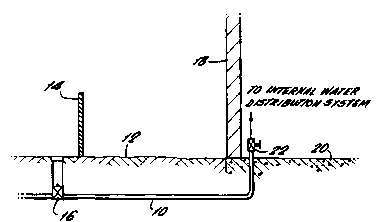Some of the information on this Web page has been provided by external sources. The Government of Canada is not responsible for the accuracy, reliability or currency of the information supplied by external sources. Users wishing to rely upon this information should consult directly with the source of the information. Content provided by external sources is not subject to official languages, privacy and accessibility requirements.
Any discrepancies in the text and image of the Claims and Abstract are due to differing posting times. Text of the Claims and Abstract are posted:
| (12) Patent Application: | (11) CA 2165938 |
|---|---|
| (54) English Title: | ELECTRICALLY OPERATED STOP-COCK FOR MAINS WATER SUPPLY |
| (54) French Title: | VANNE D'ARRET A COMMANDE ELECTRIQUE POUR CANALISATION D'EAU MAITRESSE |
| Status: | Deemed Abandoned and Beyond the Period of Reinstatement - Pending Response to Notice of Disregarded Communication |
| (51) International Patent Classification (IPC): |
|
|---|---|
| (72) Inventors : |
|
| (73) Owners : |
|
| (71) Applicants : | |
| (74) Agent: | MARKS & CLERK |
| (74) Associate agent: | |
| (45) Issued: | |
| (86) PCT Filing Date: | 1994-06-29 |
| (87) Open to Public Inspection: | 1995-01-12 |
| Availability of licence: | N/A |
| Dedicated to the Public: | N/A |
| (25) Language of filing: | English |
| Patent Cooperation Treaty (PCT): | Yes |
|---|---|
| (86) PCT Filing Number: | PCT/GB1994/001413 |
| (87) International Publication Number: | GB1994001413 |
| (85) National Entry: | 1995-12-21 |
| (30) Application Priority Data: | ||||||
|---|---|---|---|---|---|---|
|
There is described an electrically operated mains water stop-cock(22). There is also described a building (18) having an internal
water distribution system in communication with an external mains water supply (10) and an electrically operated stop-cock (22) connected
to the mains water supply (10) the stop-cock (22) being capable of isolating the internal water distribution system from the external mains
water supply (10). There is also described the use of an electrically operated valve means (22) as a stop-cock to isolate a private water
distribution system from a mains water supply (10). There is also described a method of isolating the internal water distribution system of
a building (18) from an external mains water supply (10) with which the internal water distribution system is in communication comprising
the steps of providing an electrically operated stop-cock (22) at the junction between the internal water distribution system and the external
mains water supply (10) and actuating the stop-cock (22) to isolate the internal water distribution system.
L'invention concerne un robinet de retenue (22) raccordé à un réseau de distribution d'eau, actionné électriquement. L'invention concerne également un bâtiment (18) comportant un système de distribution d'eau interne communiquant avec un réseau de distribution d'eau externe (10) et un robinet de retenue (22) actionné électriquement et raccordé audit réseau de distribution d'eau (10). Le robinet de retenue (22) a la capacité d'isoler le système de distribution d'eau interne du réseau de distribution d'eau externe (10). L'invention concerne également l'utilisation d'une vanne (22) actionnée électriquement fonctionnant comme un robinet de retenue afin d'isoler un système de distribution d'eau privé d'un réseau de distribution d'eau (10). L'invention concerne aussi un procédé d'isolation du système de distribution d'eau interne d'un bâtiment (18) d'un réseau de distribution d'eau externe (10) avec lequel communique le système de distribution d'eau interne, procédé qui consiste à monter un robinet de retenue (22) actionné électriquement au niveau du raccordement du système de distribution d'eau interne et du réseau de distribution d'eau externe (10), et à actionner le robinet de retenue (22) afin d'isoler le système de distribution d'eau interne.
Note: Claims are shown in the official language in which they were submitted.
Note: Descriptions are shown in the official language in which they were submitted.

2024-08-01:As part of the Next Generation Patents (NGP) transition, the Canadian Patents Database (CPD) now contains a more detailed Event History, which replicates the Event Log of our new back-office solution.
Please note that "Inactive:" events refers to events no longer in use in our new back-office solution.
For a clearer understanding of the status of the application/patent presented on this page, the site Disclaimer , as well as the definitions for Patent , Event History , Maintenance Fee and Payment History should be consulted.
| Description | Date |
|---|---|
| Time Limit for Reversal Expired | 1999-06-29 |
| Application Not Reinstated by Deadline | 1999-06-29 |
| Deemed Abandoned - Failure to Respond to Maintenance Fee Notice | 1998-06-29 |
| Application Published (Open to Public Inspection) | 1995-01-12 |
| Abandonment Date | Reason | Reinstatement Date |
|---|---|---|
| 1998-06-29 |
The last payment was received on 1997-06-27
Note : If the full payment has not been received on or before the date indicated, a further fee may be required which may be one of the following
Patent fees are adjusted on the 1st of January every year. The amounts above are the current amounts if received by December 31 of the current year.
Please refer to the CIPO
Patent Fees
web page to see all current fee amounts.
| Fee Type | Anniversary Year | Due Date | Paid Date |
|---|---|---|---|
| MF (application, 3rd anniv.) - small | 03 | 1997-06-30 | 1997-06-27 |
Note: Records showing the ownership history in alphabetical order.
| Current Owners on Record |
|---|
| WILLIAM JOHN VISSER |
| Past Owners on Record |
|---|
| None |